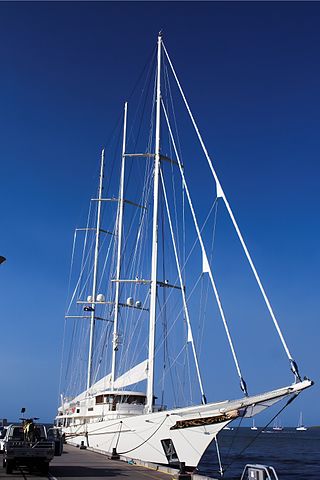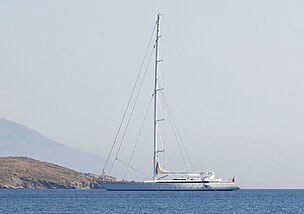
The Norfolk wherry is a type of sailing boat used on The Broads in Norfolk and Suffolk, England. Three main types were developed over its life, all featuring the distinctive gaff rig with a single, high-peaked sail and the mast stepped well forward.

A Bermuda rig, Bermudian rig, or Marconi rig is a configuration of mast and rigging for a type of sailboat and is the typical configuration for most modern sailboats. This configuration was developed in Bermuda in the 17th century; the term Marconi, a reference to the inventor of the radio, Guglielmo Marconi, became associated with this configuration in the early 20th century, because the wires that stabilize the mast of a Bermuda rig reminded observers of the wires on early radio masts.

A Thames sailing barge is a type of commercial sailing boat once common on the River Thames in London. The flat-bottomed barges, with a shallow draught and leeboards, were perfectly adapted to the Thames Estuary, with its shallow waters and narrow tributary rivers. The larger barges were seaworthy vessels, and were the largest sailing vessel to be handled by just two men. The average size was about 120 tons and they carried 4,200 square feet (390 m2) of canvas sail in six working sails. The mainsail was loose-footed and set up with a sprit, and was brailed to the mast when not needed. It is sheeted to a horse, as is the foresail; they require no attention when tacking. The foresail is often held back by the mate to help the vessel come about more swiftly.

Ronald John Holland is a yacht designer, who came to prominence in the 1970s with his successful racing designs, and is now best known for his superyachts such as Mirabella V and Ethereal. He is now based in Vancouver, British Columbia, Canada.

Maltese Falcon is a full-rigged ship using DynaRig technology, which was built by Perini Navi in Tuzla, Istanbul, and commissioned by her first owner, Tom Perkins. She is one of the world's most complex and largest sailing yachts at 88 m (289 ft), similar in size to the Athena and Eos. The vessel dropped its BVI flag in 2008 and was purchased by Pleon Ltd, which put it to charter use.
The Achilles 24 is a British sailboat that was designed by Oliver Lee and Chris Butler as a cruiser-racer and first built in 1968.

Athena is a clipper-bowed three-masted gaff-rigged schooner built by Royal Huisman in 2004 for Internet entrepreneur James H. Clark. Clark purchased a 47.4 meter sloop, Hyperion, from Royal Huisman in 1998. As Hyperion was nearing completion, Clark began to consider the possibilities of a larger yacht, which could include a theater, library, more guest space and a more capable galley, taking inspiration from the 1920s Krupp built motor yacht "Talitha".
The Norfolk Heritage Fleet Trust is a waterway society and charitable trust based at Hunter's Yard, Ludham on the Norfolk Broads, England, UK. The Trust maintains and hires out a fleet of wooden sailing yachts from the 1930s.

Lulworth is a racing yacht that was built in Southampton in 1920.
The following outline is provided as an overview of and topical guide to sailing:
The Ranger 23 is an American trailerable sailboat, that was designed by Gary Mull as an International Offshore Rule quarter-ton racer.
The Ranger 32 is an American sailboat that was designed by Gary Mull as an International Offshore Rule Three-Quarter Ton class racer and first built in 1973. The design is out of production.

The Kirby 25 is a Canadian trailerable sailboat, that was designed by Bruce Kirby as a racer and first built in 1978. The design is out of production.

Black Pearl is a sailing yacht launched in 2016, which is 106.7 meters (350.1 ft) in length. It has three DynaRig masts supporting a sail area of 2,900 square meters (31,215 sq ft). The yacht was known during its build process originally as Oceanco Y712 and thereafter as "Project Solar". The hull is steel, the superstructure aluminum, and the masts carbon fiber. The yacht is owned by the family of Russian billionaire Oleg Burlakov, who died in 2021.
Hemisphere is the largest sailing catamaran and the largest sailing private yacht catamaran in the world since 2011. She is 145 feet (44 m) long and built by boat builder Pendennis (UK). The vessel has won five different industry awards, including for the interior finishing. In suitable weather, Hemisphere goes 13 knots, with a top sailing speed of 20 knots. VPLP collaborated with Michael Leach Design for the interior design, and the yacht has over 1300 square feet of deck space. Some of the deck spaces include areas including the wheelhouse, flybridge, and salon.
The Marlow-Hunter 47 is an American sailboat that was designed by the Hunter Design Team as a cruiser and first built in 2016.

The Topper Topaz is a British single-handed or two-handed sailing dinghy that was designed as a beginner and intermediate racer.
The ETAP 23iL is a Belgian trailerable sailboat that was designed by Jacques de Ridder as a cruiser and first built in 1994.
The Mark 25 is an American trailerable sailboat that was designed by Canadian George Harding Cuthbertson, as one of the first works under his new design firm Motion Designs Limited after he left C&C Design. The boat was intended as a racer-cruiser and first built in 1984.
Camper and Nicholson is a yacht design and manufacturing company based in Gosport, England, for over two hundred years, constructing many significant vessels, such as Gipsy Moth IV and Prince Philip's yacht Bloodhound. Its customers included Thomas Sopwith, William Kissam Vanderbilt II and George Spencer-Churchill, 6th Duke of Marlborough. Its yachts competed in The America's Cup, The Fastnet Race, the Olympics, the Ocean Race and many other yacht races. It also built a number of small warships, notably during the two World Wars, and some as late as the 1950s.











